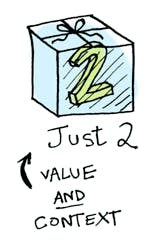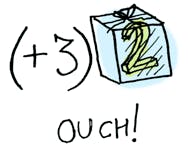Result Type, Monadic Type, and Why There Is Always a Map Function
Wikipedia definition: https://en.wikipedia.org/wiki/Result_type
a result type is a Monadic type holding a returned value or an error code. They provide an elegant way of handling errors, without resorting to exception handling; when a function that may fail returns a result type, the programmer is forced to consider success or failure paths, before getting access to the expected result; this eliminates the possibility of an erroneous programmer assumption
NOTE: Result types are widely used in functional languages, and some other languages provide support for them out of the box, while others require additional packages.
Why Would We Like to Use the Result Type
- We want to explicitly define types that function can return
- Easy to define if the return value is a success or error
- No need to design our own custom return types, we get what we need out of the box
Result should only be used as part of the domain modeling process, to document expected return values. And then to ensure at compile-time that you handle all the possible expected error cases.
Against Railway-Oriented Programming
Result Type Example with ts-result
Hi! This is the Result…

Source for all images: https://hackernoon.com/kotlin-functors-applicatives-and-monads-in-pictures-part-1-3-c47a1b1ce251
import { Ok, Err, Result } from "ts-results";
// These are just some helper functions
const someNumberInResult = () => Ok(2);
const someErrorInResult = () => Err(2);
const addThreeToNumber = (x: number) => x + 3;
const result = someNumberInResult();
// Result is a data type that has a value inside
// Also more specific type if it is a success or an error
// Ok type and Err type
// result: Ok ( 2 )
// Imagine the result as a container with the value inside
// properties to check data
console.log("Is result Ok", result.ok);
console.log("Is result Err", result.err);
console.log("Value from result", result.val);
// TIP: use only these and forget all monadic data type stuff
// It is ok to leave the presentation now
// and then some attached functions and apply manipulations to the data
// map unwraps the value from Result, executes the function, and produces a new Result
const updatedResult = result.map((r) => r + 3);
// Ok ( 5 )
// unwrap returns the value
console.log("Unwrap result", updatedResult.unwrap());
// What is the difference between val and unwrap?
// Unwrap will throw an error when if Result is Err
The result type has a map-function. Why is the map-function called map?
Currently most famous map-function: Array.prototype.map(). The map-function creates a new array populated with the results of calling a provided function on every element in the calling array.
The map name comes originally from mathematics and computer scientists love that stuff.
map is the name of a higher-order function that applies a given function to each element of a function, e.g. a list, returning a list of results in the same order.
higher-order function is a function, that takes function(s) are argument and/or returns a new function.
The concept of a map is not limited to lists: it works for sequential containers, tree-like containers, or even abstract containers such as futures and promises.
const result = someNumberInResult();
const newFunction = (x: number) => x * 2;
const newResult = result.map(newFunction);
// From Result definition:
/**
* Maps a `Result<T, E>` to `Result<U, E>` by applying a function to a contained `Ok` value,
* leaving an `Err` value untouched.
*
* This function can be used to compose the results of two functions.
*/
// So in terms of Ok: Ok<T> -> Ok<U>
// NOTE: type doesn't need to change with applied function Ok<T> -> Ok<T>
const updatedResult = result.map(addThreeToNumber);
// Ok<number> -> Ok<number>
console.log("Updatedresult value", updatedResult.val);
// Let's apply a function that transforms number to a string
const resultAsString = result.map((x) => x.toString());
// Ok<number> -> Ok<string>
console.log("resultAsString values type", typeof resultAsString.val);
Summary: map applies a function to contained value and returns a new value
So What Is That Monadic Data Type?
Monadic (being or relating to a monad)
Not important in real life, but let’s try to get some idea of what the monad is
Normal Functions

const value = 2;
const addThree = (x: number) => x + 3;
const sum = addThree(value);
console.log("Result:", result);
Monadic Data Types
Some monad examples. These are not true monads, but close enough. True monads can be found only from Haskell-land.

- Optional (has value, doesn’t have value)
- Promise (has value or error at some point)
- Result (Ok, Error, and value)
We can’t apply normal functions to our “monad” container

const context: Result<number, string> = someNumberInResult();
const addThree = (x: number) => x + 3;
// Doesn't work as value is wrapped to Result (context)
const sum = addThree(context); // Error
Apply functions with a map!

const context: Result<number, string> = someNumberInResult();
const addThree = (x: number) => x + 3;
const newContext = context.map(addThree);
console.log("Result:", newContext.val);
So…
Monad is a container that has a value and some attached functions (map etc.). The value will be evaluated when all operations are executed 👍
And now you know why a map has a special place in function naming.
Links
Images are from: https://hackernoon.com/kotlin-functors-applicatives-and-monads-in-pictures-part-1-3-c47a1b1ce251
Functional Programming presentation: https://ttu.github.io/functional-programming-presentation/
Presentation - How to Get value out of your monad - Mark Seemann
TLDW: You don’t. Inject the desired behavior into the monad.
const endpoint = (params) => {
return fetchDataAsMonad(params) // fetchDataAsMonad returns a monad
.map(data => service.canProcessData(data )) // canProcessData returns a monad
.map(data => otherService.tryUpdateData(data)) // tryUpdateData returns a monad
.map(result => xxx.doSomethingElse(result)) // doSomethingElse returns a monad
.map(result => utils.intoHtmlResponse(result) // intoHtmlResponse returns a monad
.unwrap(); // Get value out of the monad
};
